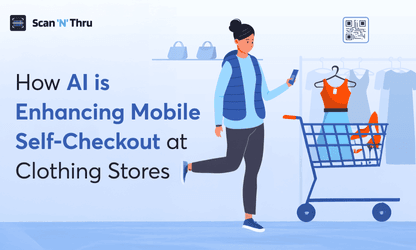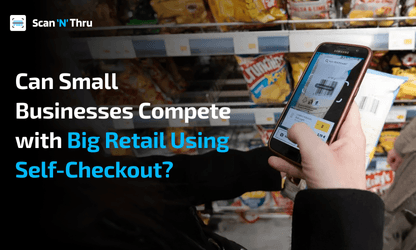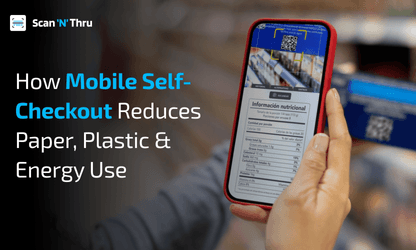Some retailers treat store layout like it’s set in stone. They design it once, lock it in, and hope it works.
But in a world where footfall is unpredictable and customer expectations are constantly shifting, that rigidity doesn’t serve anyone, especially not your bottom line.
Store layout isn’t just about aesthetics. It’s about movement, margins, and experience. And as customer behavior evolves, there are several space-saving retail solutions that push retailers like you to completely rethink how their store space works.
One such solution is mobile self-checkout.
In this blog, you will discover how mobile self-checkout is a tool that can influence and reshape your store layout for optimized space usage and store operations.
Let’s explore why this technology is more than just a faster way for in-store checkout and payment.
So, first things first…
Why store space matters more than ever in retail
In retail, space equals money. And how you use that space can either multiply or quietly eat away at your profits. There are multiple factors involved here:
The high cost of underutilized space
Every square foot counts.
Real estate costs are constantly rising, and profit margins are under pressure. So, leaving any space underused, like allocating huge sections to static checkout lanes or cash registers, is inefficient.
Besides, it’s also expensive. It’s like you’re paying for a footprint that’s not pulling its weight.
What’s worse is that it could be costing you in missed revenue opportunities.
Enhancing customer flow and engagement
A well-designed layout nudges people to explore your store. It keeps them moving. It encourages discovery.
But when shoppers are forced to navigate around traditional registers or wait in long lines, the experience turns from enjoyable to frustrating. That’s a problem. And eventually, it becomes a reason to completely abandon shopping.
So, it’s vital to figure out how your customers can stay in your store without friction. Because that’s how they are more likely to buy.
Adapting to changing consumer expectations
Today’s shoppers aren’t patient. They are too time-conscious. They want speed, efficiency, and control.
This is because they’re used to seamless online shopping experiences and expect the same in physical stores.
Traditional layouts often fail to meet those expectations, which leads to friction at exactly the wrong moments.
What traditional checkout zones get wrong today
The way most stores handle checkout is outdated. Let’s call it what it is: a holdover from a time when scanning and paying required bulky hardware and a dedicated cashier.
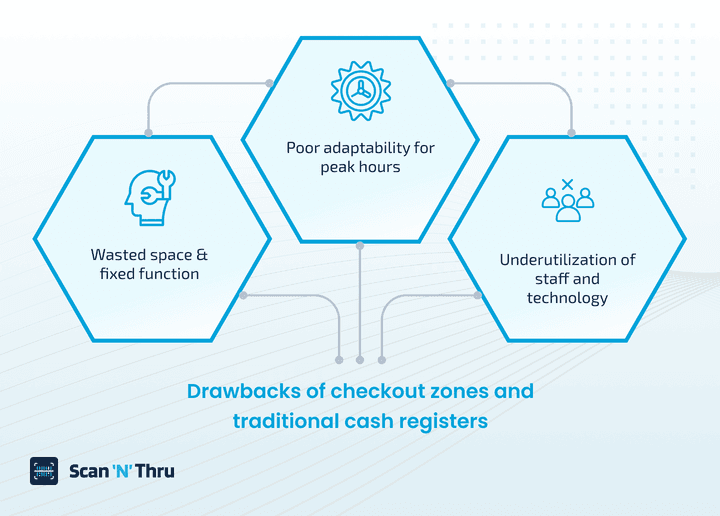
Wasted space & fixed function
Rows of registers are static. They do one thing and take up too much room doing it. During peak hours, they bottleneck. During lulls, they just sit there, unused.
Worse, they force queues to form in your most valuable front-of-store real estate.
Poor adaptability for peak hours
Even when retailers try to adapt with express lanes or pop-up POS systems, they’re just patching over a flawed system. These temporary fixes often clutter the space and add more confusion than convenience.
Underutilization of staff and technology
Traditional checkouts require staff to be physically present, even if only one customer is waiting. That’s inefficient.
Plus, the fixed POS system often doesn’t integrate well with real-time data or customer personalization, thereby wasting both labor and insight.
Read more - How Scan and Go Challenges Traditional Retail Norms
How mobile self-checkout impacts store layouts
Mobile self-checkout technology makes your store a place without checkout lanes.
It becomes a store where customers scan items with their smartphones as they shop. They pay (also via smartphones if they prefer) and leave without queuing.
That’s the promise of mobile self-checkout, and its impact on store design is dramatic. Let’s see how:
Checkout without checkout zones
No bulky counters. No fixed stations.
Instead, you open up floor space, reduce bottlenecks, and give customers freedom to move.
It’s a cleaner, more open environment, and one that feels naturally customer-first.
More space for revenue-generating areas
The freed-up space doesn’t go to waste. It becomes a canvas.
Here’s what you can do with it:
- Expanded product displays for high-margin items
- Seasonal pop-ups that keep the store fresh
- Interactive zones where shoppers can test or sample products
- Community spaces for small events or workshops
- Localized inventory to cater to neighborhood trends
- Anything else that you wished to do if you had that ‘extra’ space.
You’re not just reclaiming square footage; you’re reinvesting it in things that drive revenue and loyalty.
Dynamic design that adapts to traffic patterns
With mobile self-checkout systems, customers naturally spread out. They will be near the shelf where they need to buy their stuff.
There’s no singular point of congestion. That means you can have a natural flow rather than forcing people to end up in the same place.
Benefits of store layout optimization for mobile self-checkout
The impact of self-checkout mobile apps goes beyond autonomy and convenience.
Here’s what retailers like you actually gain by rethinking store layout around mobile self-checkout:
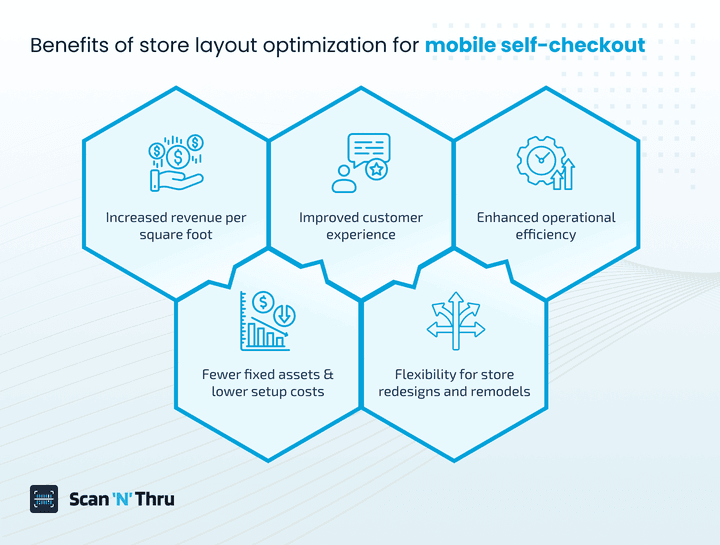
Increased revenue per square foot
Less space wasted on checkout means more space for selling.
Premium displays. Cross-sell zones. Impulse items right at the customer's fingertips on their phones.
Improved customer experience
Mobile self-checkout technology means no queues and no waiting. Just these two things are enough to make it an instant hit among your customers.
Because who doesn’t love control and freedom in their shopping journey?
When you allow that, it results in higher satisfaction, more repeat visits, and stronger brand affinity.
Enhanced operational efficiency
You don’t need a cashier at every terminal.
You can reassign staff to customer service, stocking, or personalized assistance. These are the aspects where they create more value.
And with real-time data from mobile self-checkout apps, you can also streamline your inventory and promotional planning.
Fewer fixed assets & lower setup costs
Forget installing multiple POS terminals and paying for their maintenance.
Mobile self-checkout doesn’t involve any physical elements or equipment.
That means you save on infrastructure costs. Plus, you also future-proof your setup for scale and flexibility.
Flexibility for store redesigns and remodels
If you are one of those retailers who want to test a new store layout or rotate product focus every month, then it’s easily possible with mobile self-checkout systems. These systems make it easier to adapt without redesigning from scratch. Hence, you won’t be locked into a layout that’s built around fixed hardware.
Read more: Benefits of Implementing Scan 'N' Thru's Mobile Self-Checkout System in Retail Stores
Final words: Rethink your store from the inside out
Mobile self-checkout technology isn’t just a new and tech-savvy way for in-store checkout. It’s also a new way to think about retail space—how it’s used, how it flows, and how it contributes to both customer experience and profitability.
Retailers like you should stop anchoring your store design around the register; that’s how you will start unlocking space for more important things: engagement, experimentation, and growth.
Scan ‘N’ Thru's mobile-based self-checkout solution is built with this philosophy in mind.
Retailers like you can introduce mobile self-checkout without overhauling your existing systems, and that too without compromising flexibility, insight, and smarter store layouts.
If your store is evolving, your checkout strategy should too. Let Scan ‘N’ Thru help you do that.


